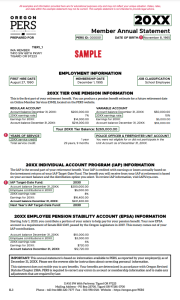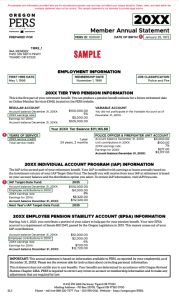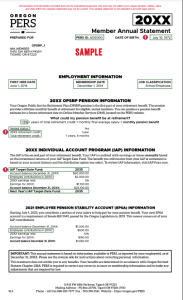How to Read Your Oregon PERS Statement – A Step-by-Step Guide
The Oregon Public Employee Retirement System (Oregon PERS) is the retirement program for all Oregon’s public service employees. Unlike other states, which have individual pension programs for various professions (one for nurses, one for teachers, one for police/fire, etc.), Oregon has just one pension program. You’re not alone if you feel confused by Oregon PERS. I often describe it as akin to tax code – a patchwork of acronyms and programs that have built on each other over time. Over the last decade, I’ve met hundreds of people like you, trying to make sense of Oregon PERS and its role in retirement savings.
In this post, I will break down your annual Oregon PERS Statement. We’ll take it one section at a time, looking at a sample statement, whether you’re Tier One (those who joined Oregon PERS before January 1996), Tier Two (those who joined between January 1996 and August 2003), or OPSRP (those who joined after August 2003). You can continue reading along here or watch me walk through it in the video below. (If instead, you’re looking for help navigating your Oregon PERS Benefit Estimate, you can find our blog on that here: How to Read Your Oregon PERS Benefit Estimate.)
Overview of Your Oregon PERS Statement
Your Oregon PERS statement provides a snapshot of your retirement benefits and contributions. These statements are essential tools for those of you looking to understand your financial standing and make informed decisions about retirement planning. The statements serve several key purposes:
1. Provide you with information about your pension
Whether you’re Tier One, Tier Two, or OPSRP, you have some level of pension benefit associated with your Oregon PERS retirement. That said, the information that comes on your Oregon PERS statement won’t help you understand how much you are entitled to each month in retirement. Like Baskin Robbins, there are many flavors of PERS benefits to choose from (more on that later).
2. Report on your years of service to help determine retirement eligibility as defined through Oregon PERS
When you started with Oregon PERS, you became an active member after your six-month waiting period. You are vested as soon as you complete at least 600 hours of service in each of five calendar years. These years don’t need to be consecutive, but there can’t be a gap of more than five years between the years in which you accumulate those hours. If you reach ‘normal retirement age,’ you become vested regardless of years of service. The big difference between Tier One/Tier Two and OPSRP regarding retirement eligibility is what is considered the ‘normal retirement age.’ To learn more about Tier One and Tier Two retirement eligibility, click here. To learn more about OPSRP retirement eligibility, click here.
3. Provide information on your Individual Account Program (IAP)
The Individual Account Program (IAP) is a defined contribution retirement savings plan designed to supplement your pension. Through the IAP, you can make voluntary 6% contributions from your paychecks and, in some cases, employer contributions, which are then invested. Upon retirement, you can access your IAP account balance to provide additional financial security alongside your pension benefits, offering greater flexibility and control over your retirement assets.
4. Provide information on the Employee Pension Stability Account (EPSA)
The Employee Pension Stability Account (EPSA) is a relatively new addition to PERS, started in July 2020. It was created to address the increasing cost of funding pension benefits, and its purpose is to ensure that your pension benefit is available upon retirement.
While there are differences between statements, most contain the sections I’ve outlined here. Examples of Tier One, Tier Two, and OPRSP statements are below. The hyperlinks will take you to helpful .pdfs with pop-up comments on each section.
Key Components of Your PERS Statement
Let’s go through the statement section by section.
Personal Information
The top of your statement will cover the brass tacks: your name, address, date of birth, and PERS ID. Below that, you’ll find your first hire date (the date you were hired), membership date (when you became eligible to make PERS retirement contributions – usually six months after your hire date), and job classification. Your eligible retirement date depends, in part, on your job classification, with earlier retirement dates for police and fire members.
A great planning opportunity to explore as you near retirement is the ability for Oregon PERS Tier One/Tier Two members to ‘buy back’ the six-month waiting time. This can expedite your eligible retirement date and increase your life-long pension amount. Click here to learn more about buying waiting time. There are also purchases available to certain members of Oregon PERS; you can check this link to see if any apply to you.
Pension Information
The next section will focus on your pension, and there are differences between what shows up in this section on a Tier One/Tier Two and OPSRP statement.
Tier One/Tier Two
If you’re a Tier One/Tier Two employee, you will see an overview of your account balance and earnings rates for your regular account. If you participate in the Variable Annuity Program (VAP), you will also see that information listed. The regular account earnings rate is a fixed interest rate adopted by the PERS board annually. The variable account earnings are based on your account balance, an assumed interest rate, and an annuity factor determined by your age. The risk with the VAP is a bit higher, but so is the return potential. To learn more about the VAP program, click here. You can determine whether you want your pension to be fixed or variable at retirement. As the name implies, the variable option will change from month to month.
The balance listed will be used to pay for a portion of your benefit. This doesn’t represent your total pension, as it doesn’t include what PERS will contribute.
PERS uses two or three methods to calculate your monthly pension, all of which rely on your years of service to some extent (you end up with the highest amount). Your years of service credit will increase so long as you work 600+ hours that year.
Police and firefighters can purchase additional units with after-tax dollars to provide additional monthly income, usually for five years.
OPSRP
The 1.5% formula for the OPSRP pension is designed to give you about 45% of your salary during retirement.
Vested status helps you understand if you can receive a pension through PERS, even if you’re no longer working for a PERS employer. Typically, you reach vested when you meet the 600+/hour/5-year criteria mentioned above.
Retirement credits refer to the amount of time you have worked for a PERS employer, and again, those will increase as you continue to work 600+/hours.
Getting to Your Pension Amount
Frustratingly, for some, the monthly pension benefit doesn’t appear on your annual statement. If you want to estimate your monthly PERS benefit, you have two choices. The first and easiest is to log on to PERS Online Member Services to pull a pension estimate. While you cannot get a formal benefit estimate from PERS until you’re two years out from retirement eligibility, you can use their online resource to pull estimates as often as you like.
If you prefer to calculate your estimate by hand (maybe you love math or hate online logins), you’ll need to know your three highest-grossing years. For general service, the Tier One/Tier Two Full Formula Benefit Factor calculation is 1.67% x years of service credit x your highest grossing three years salary = your estimated annual pension in retirement. E.g., .0167 x 30 yrs x $75,000 = $37,575/year gross pension (2% for police and fire).
For OPSRP, the calculation is 1.5% x years of service credit x your highest grossing three years salary = your estimated annual pension in retirement. E.g., .015% x 30 x 75,000 = $33,750/year gross pension (1.8% for police and fire).
Tier One will add the Formula Plus Annuity and Money Match to that amount. Tier Two will add the Money Match. These quirks mean that these back-of-the-napkin estimates are often more conservative than what we find when we pull an estimate. This nuance between tiers is why I recommend using the online system.
Individual Account Program (IAP) Information
Contributions to your Individual Account Program (IAP) are invested in a target-date retirement fund. Target retirement funds are investment funds designed to simplify retirement planning. They automatically adjust the asset allocation mix (stocks, bonds, and sometimes other assets) based on the investor’s target retirement date (in this case, based on your age). As the retirement date approaches, the fund gradually shifts to a more conservative allocation, reducing risk exposure. You can change this if you prefer an investment strategy that is different than your birthdate dictates. You can learn more about the IAP Target-Date Funds here.
At retirement, you have a few options for how this account can support you. You can roll it into a traditional Individual Retirement Account (IRA) or take installments. Often, the right decision comes down to assessing your income needs in retirement. How much will your pension be? How much will Social Security be? Will you want fixed installments from the IAP, or would you prefer to keep your options open?
Your IAP will function much like other IRA accounts you may have. Withdrawals will be taxed at ordinary income rates, and the account will be subject to required minimum distributions. If you have charitable intent, these RMDs can be handled using a Qualified Charitable Distribution strategy.
Employee Pension Stability Account (EPSA) Information
If you earn over $3,570/month (2023), a portion of the 6% that goes into your IAP will be redirected to fund the EPSA. If you’re Tier One/Tier Two, 2.5% will go to the EPSA, and the remaining 3.5% will continue going to the IAP. OPSRP, 0.75% will go to EPSA, 5.25% to the IAP. Like with most aspects of Oregon PERS, there’s nuance here. If you want to learn more about the EPSA, click here.
Conclusion
Your pension and IAP are just two elements of your retirement plan. As an Oregon PERS employee, you have the ability to purchase service credits, which I mentioned earlier. You can also access the Oregon Savings Growth Plan (OSGP) for additional pre-tax savings. You also have Social Security. Maybe you have retirement and investment accounts outside PERS. If you’re in partnership, multiply the complexity of income options and tax liability by two. This is how we accumulate wealth over our lives, and without pulling everything together into a comprehensive plan, it’s impossible to see how they all work together.
Don’t hesitate to reach out if you’re looking for a thought partner to process your unique Oregon PERS statement and how it fits into your retirement plan. I welcome the conversation.
FAQ on Reading Your PERS Statement
What is an Oregon PERS statement, and why is it important for retirement planning?
The Oregon PERS statement comprehensively recaps your retirement benefits and contributions within the Oregon Public Employee Retirement System. This statement is crucial for understanding your financial status and making informed retirement decisions. It includes details about your pension, years of service, the Individual Account Program (IAP), and the relatively new Employee Pension Stability Account (EPSA). Reviewing this statement annually and comparing it with previous years can offer insights into your retirement progress.
How does the Oregon PERS system define retirement eligibility?
Retirement eligibility in the Oregon PERS system depends on factors such as membership tier and years of service. To become vested, you must complete at least 600 hours of service in each of five calendar years. These years don’t need to be consecutive. However, there can’t be a gap of more than five years between the years in which you accumulate those hours. If you reach the “normal retirement age,” you become vested regardless of years of service. Differences between Tier One, Tier Two, and OPSRP members include variations in “normal retirement age.”
What is the Individual Account Program (IAP), and how does it supplement pension benefits?
The IAP is a defined contribution retirement savings plan within the Oregon PERS system. Members can contribute 6% of their paychecks; employers might also contribute in some cases. These contributions are invested in a target-date retirement fund, automatically adjusting the asset allocation based on your target retirement date. Upon retirement, the IAP account balance can be accessed alongside pension benefits, providing added financial security and flexibility in retirement planning.
What is the Employee Pension Stability Account (EPSA), and how does it impact contributions?
The EPSA is a recent addition to the Oregon PERS system. It was introduced in July 2020 to address rising pension benefit costs. If you earn over a certain threshold, a portion of your 6% IAP contributions will be redirected to fund the EPSA. The percentages differ for Tier One, Tier Two, and OPSRP members. The EPSA ensures that your pension benefits remain available upon retirement. It’s important to understand how the EPSA affects your contributions and how it contributes to the overall stability of the pension system.









1 Comment